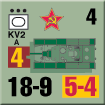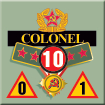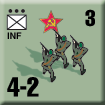| Panzer Grenadier: Workers & Peasants
Scenario Preview, Part Two
February 2014
And the previewing congtinues with the scenarios from the Army Group North section of our Panzer Grenadier supplement, Workers and Peasants.
ARMY GROUP NORTH
Scenario One
On Their Own
15 July 1941
 In an effort to secure a bridge over the Luga River, Kampfgruppe Raus had traveled for two days and nights with little rest. The narrow roads they traveled had never seen a motor vehicle, so every breakdown created an instant roadblock as there was no room on either side to bypass stalled vehicles. Arriving late in the afternoon the Germans attacked the bridge, which was guarded by an armored security detachment supported by a large force of militia. In an effort to secure a bridge over the Luga River, Kampfgruppe Raus had traveled for two days and nights with little rest. The narrow roads they traveled had never seen a motor vehicle, so every breakdown created an instant roadblock as there was no room on either side to bypass stalled vehicles. Arriving late in the afternoon the Germans attacked the bridge, which was guarded by an armored security detachment supported by a large force of militia.
Note: This scenario uses a board from Elsenborn Ridge, a board and pieces from Road to Berlin, and pieces from Eastern Front. Only use leaders from Eastern Front and this supplement.
Conclusion
This was the baptism of fire for the Soviet militiamen, and it showed. They went to ground as soon as they took fire and let the Soviet armor advance alone. The Kommisars finally got their men going again just in time to see the armor decimated, so when the militiamen went to ground again no one could get them going.
Commentary
The Soviet militia vastly outnumbers the Germans, and the light German tanks of Kampfgruppe Raus are badly outmatched by the KV-1s guarding the bridge. The Soviet militia can just throw up walls of humanity ahead of the German infantry to slow them down so they’ll have trouble reaching the bridge by the end of play. But the Soviets must hold multiple territorial objectives, so the Germans will have their chances to win.
Scenario Two
Swamp Rats
7 September 1941
After the 1st Separate Mountain Brigade was forced to retreat from Mga Station and into the surrounding swamps, part of an NKVD rifle division was sent to their aid. It was to no avail, as the Germans slowly pushed them back towards Sinyavino. The loss of that village would render the defenses in the sector untenable, so the Soviets launched an all-out effort to hold the position.
Note: This scenario uses a board from August 1914, boards and pieces from Eastern Front, Road to Berlin and 1940: The Fall of France, and pieces from Sinister Forces. Use only leaders from Sinister Forces, Eastern Front and this supplement.
Conclusion
Parts of two mobile divisions easily drove through the Soviet defenders. The NKVD men limped away to the west while 1st Separate Mountain Brigade fell back to the east to make a stand at Sinyavino. It was no use and they soon lost the village, but that would be overshadowed by the failure of inform Stavka of the loss of Fortress Shlissel'burg. When Stalin found out about it from a German communiqué, the front commander was ordered to Moscow and Marshal Zhukov was sent there to salvage the situation.
Commentary
This is a very large scenario in a very swampy area, with both sides bringing very large forces to the table (17 German tank units, 41 Soviet infantry). The Germans have a pretty high bar to reach to win, but then, they do have 17 tank units.
Scenario Three
Discovered
11 September 1941
 The morning found 6th Panzer Division cleaning up its flanks. Once that was accomplished, four battalions managed to infiltrate almost all the way through the Kransnogvardeisk Fortified Region before being discovered. Soon enemy cavalry arrived to drive them back. The morning found 6th Panzer Division cleaning up its flanks. Once that was accomplished, four battalions managed to infiltrate almost all the way through the Kransnogvardeisk Fortified Region before being discovered. Soon enemy cavalry arrived to drive them back.
Note: This scenario uses boards from Battle of the Bulge and Elsenborn Ridge, boards and pieces from Eastern Front and pieces from Road to Berlin. Only use leaders from Eastern Front and this supplement.
Conclusion
The Soviet attack was dealt with and the advance continued. By the following night, Kransnogvardeisk would fall under the swastika. As the German juggernaut rolled on it appeared nothing short of a miracle would save Leningrad.
Commentary
This is a large but relatively quick scenario on a relatively thin board, with the Germans entering on the south edge and trying to get units off the north edge while the Soviets try to stop them. The Soviets have plenty of entrenchments with lots of HMG units to man them, but their infantry is relatively weak so their cavalry will be their main striking force. That will be a tough job against a higher-morale opponent with armor support.
Scenario Four
Zelenets Station
8 November 1941
The 8th Panzer Division had been ordered east through swampy terrain with few roads in order to outflank the defenders of Zelenets Station. A heavy snow had recently fallen, further hampering movement.
Note: This scenario uses boards from August 1914, and boards and pieces from Eastern Front and Road to Berlin. Only use leaders from Eastern Front and this supplement.
Conclusion
The Soviets spotted the move to leverage them out of Zelenets Station and sent a reinforced rifle division to deal with the problem. On a bitterly cold day (-20 Fahrenheit) they attacked at first light. Working their way around and through the numerous swamps they drove off the invaders.
Commentary
 This is another large scenario where a Soviet wall of humanity tries to stop a German armored advance. The initial RKKA defense is pretty weak, with low-uality infantry trying to hold the line against a panzer advance. And then the cavalry arrives. Lots and lots of cavalry. Cavalry-based scenarios are 37.2 percent more fun than those with no cavalry at all. You can look it up. This is another large scenario where a Soviet wall of humanity tries to stop a German armored advance. The initial RKKA defense is pretty weak, with low-uality infantry trying to hold the line against a panzer advance. And then the cavalry arrives. Lots and lots of cavalry. Cavalry-based scenarios are 37.2 percent more fun than those with no cavalry at all. You can look it up.
Scenario Five
Patriots
11 November 1941
After being delayed for almost two weeks, the Soviets were finally prepared to move on Ust'-Tosno. It had been determined that whoever controlled the stone houses there would control the planned bridgehead over the Tosno River, but it had also been determined that assaulting the village was akin to suicide. So the request went out for volunteers, and unsurprisingly many patriots came forward.
Note: This scenario uses a board from Road to Berlin and boards and pieces from Eastern Front.
Conclusion
The after-action reports from both sides vary so widely that it is hard to ascertain what really happened. The only certainty is that the Germans were still in procession of Ust'-Tosno when the battle ended. The Soviets would throw more and more men and materiel into the battle in the coming days but would be constantly rebuffed.
Commentary
The snow is deep and the river is wide, but that's not going to stop the Soviet shick troops from pressing the attack. They have good morale, better numbers and heavy tank support, if they can get it across the Neva River - and there aren't many Soviet engineers to get that job done. The Germans counter with a lone platoon of assault guns.
Scenario Six
Buying Time
10 December 1941
 Having driven the Hitlerites out of Tikhvin on the 9th, Soviet troops eagerly pursued them until nightfall. The Germans then decided to leave behind a rear guard while their remaining mobile units sped away to safety. Having driven the Hitlerites out of Tikhvin on the 9th, Soviet troops eagerly pursued them until nightfall. The Germans then decided to leave behind a rear guard while their remaining mobile units sped away to safety.
Note: This scenario requires a board from Road to Berlin and a board and pieces from Eastern Front.
Conclusion
On a bitterly cold day a long way from home, the German rear guard bought time for the others to escape. It came at a horrible cost for those involved, as the 151st Infantry Regiment was decimated and its motorized component fought to the last man. But their sacrifice had not been in vain, as three mobile divisions escaped unscathed to fight another day.
Commentary
Here a Soviet human wave tries to break through a thin German line. Deep snow slows the Soviet advance but the Soviets have plenty of time to get off the west edge, so the Germans will have to mount a creative defense.
Scenario Seven
Buying More Time
19 December 1941
The Germans had been driven out of Bol'shaia Vishera on the 16th with the Soviets in hot pursuit. They would need to buy some time for their fall-back positions on the Volkhov River to be completed, so on the 19th they turned to offer battle in the frozen swamps west of Bol'shaia Vishera.
Note: This scenario uses boards from August 1914 and Road to Berlin, and pieces from Eastern Front.
Conclusion
The Soviets had not expected the Germans to make a stand until reaching the Volkhov River. So when they turned and offered combat the Soviets were surprised and could not respond effectively. The Germans so dominated the fight that they abandoned their retreat until events on their flank much later made it prudent to do so.
Commentary
The battlefield is a swamp. A big, frozen swamp. The Red Army is attacking with a very large infantry force through the deep snow and frozen swamps, backed by two platoons of tiny amphibious tankettes. The Soviets need to cross the board - there's nothing on it worth capturing - and the Germans have to stop them.
That’s all for the Army Group North section. Next up, the third and final installment of this series, which covers the fighting around Borodino.
Click here to order Workers and Peasants TODAY! |
